2019 MERCEDES-BENZ CLA height
[x] Cancel search: heightPage 18 of 330
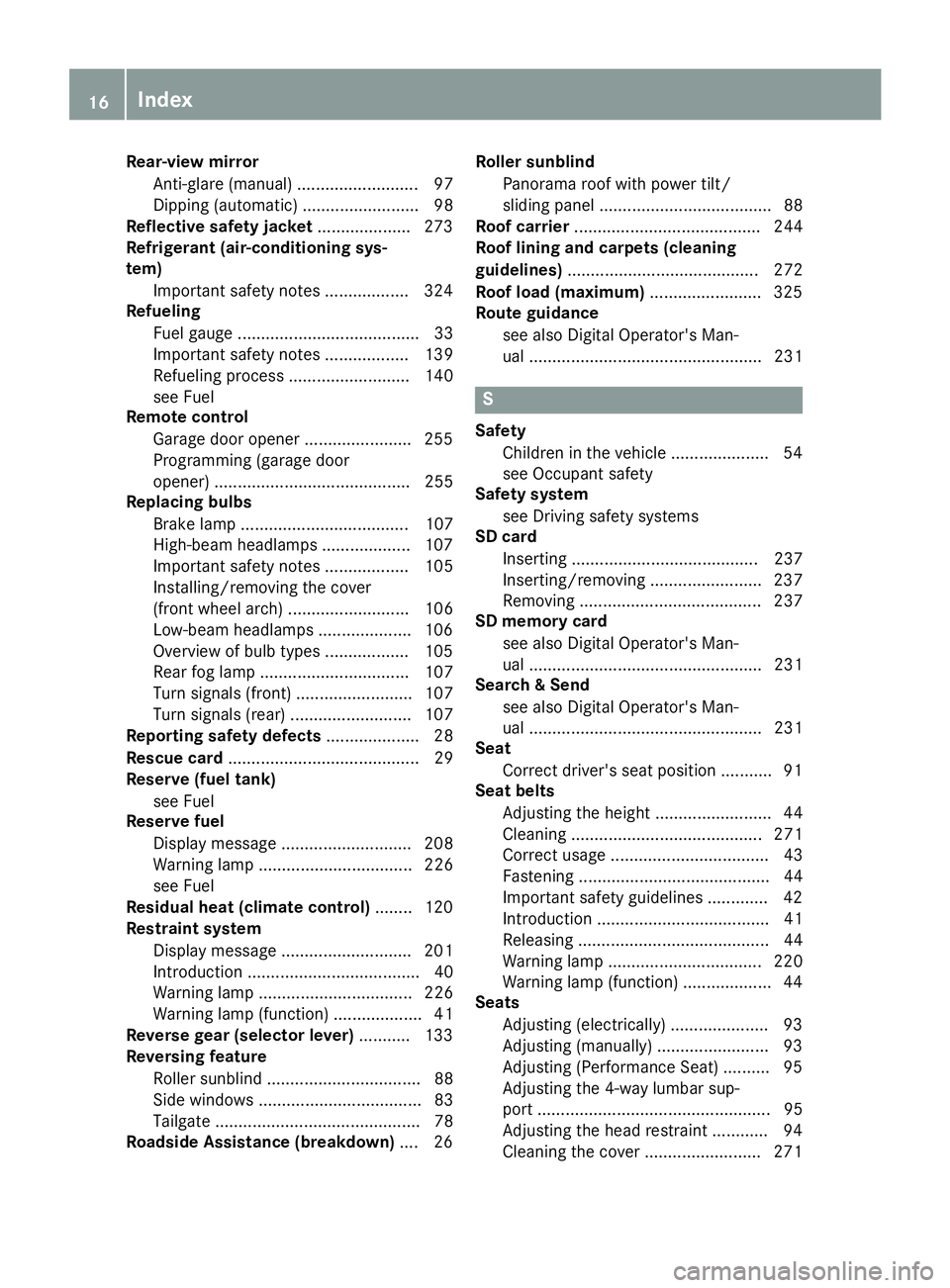
Rear-view mirror
Anti-glare (manual) .......................... 97
Dipping (automatic) ......................... 98
Reflective safety jacket.................... 273
Refrigerant (air-conditioning sys-
tem)
Important safety notes .................. 324
Refueling
Fuel gauge....................................... 33
Important safety notes .................. 139
Refueling process .......................... 140
see Fuel
Remote control
Garage door opener ....................... 255
Programming (garage door
opener) .......................................... 255
Replacing bulbs
Brake lamp .................................... 107
High-beam headlamps................... 107
Important safety notes .................. 105
Installing/removing the cover
(front wheel arch) .......................... 106
Low-beam headlamps.................... 106
Overview of bulb types .................. 105
Rear fog lamp ................................ 107
Turn signals (front) ......................... 107
Turn signals (rear) .......................... 107
Reporting safety defects.................... 28
Rescue card......................................... 29
Reserve (fuel tank)
see Fuel
Reserve fuel
Display message ............................ 208
Warning lamp ................................. 226
see Fuel
Residual heat (climate control)........ 120
Restraint system
Display message ............................ 201
Introduction ..................................... 40
Warning lamp ................................. 226
Warning lamp (function) ................... 41
Reverse gear (selector lever)........... 133
Reversing feature
Roller sunblind ................................. 88
Side windows ................................... 83
Tailgate ............................................ 78
Roadside Assistance (breakdown).... 26
Roller sunblind
Panorama roof with power tilt/
sliding panel ..................................... 88
Roof carrier........................................ 244
Roof lining and carpets (cleaning
guidelines)......................................... 272
Roof load (maximum)........................ 325
Route guidance
see also Digital Operator's Man-
ual .................................................. 231
S
Safety
Children in the vehicle ..................... 54
see Occupant safety
Safety system
see Driving safety systems
SD card
Inserting ........................................ 237
Inserting/removing ........................ 237
Removing ....................................... 237
SD memory card
see also Digital Operator's Man-
ual .................................................. 231
Search & Send
see also Digital Operator's Man-
ual .................................................. 231
Seat
Correct driver's seat position ........... 91
Seat belts
Adjusting the height ......................... 44
Cleaning ......................................... 271
Correct usage .................................. 43
Fastening ......................................... 44
Important safety guidelines ............. 42
Introduction ..................................... 41
Releasing ......................................... 44
Warning lamp ................................. 220
Warning lamp (function) ................... 44
Seats
Adjusting (electrically) ..................... 93
Adjusting (manually) ........................ 93
Adjusting (Performance Seat) .......... 95
Adjusting the 4-way lumbar sup-
port .................................................. 95
Adjusting the head restraint ............ 94
Cleaning the cover ......................... 271
16Index
Page 45 of 330

If a child younger than twelve years old andunder 5 ft (1.50m)in height is traveling in thevehicle:
Ralways secure the child in a child restraintsystem suitable for this Mercedes-Benz vehi-cle. The child restraint system must be appro-priate to the age, weight and size of the child.
Ralways observe the instructions and safetynotes on "Children in the vehicle"(Ypage 54) in addition to the child restraintsystem manufacturer's installation and oper-ating instructions
Ralways observe the instructions and safetynotes on the "Occupant classification system(OCS)". (Ypage 47)
GWARNING
The seat belts may not perform their intended
protective function if:
Rthey are damaged, modified, extremely
dirty, bleached or dyed
Rthe seat belt buckle is damaged or
extremely dirty
Rthe Emergency Tensioning Devices, belt
anchorages or inertia reels have been modi-
fied.
Seat belts may be damaged in an accident,
although the damage may not be visible, e.g.
due to splinters of glass. Modified or damaged
seat belts may tear or fail, e.g. in an accident.
Modified Emergency Tensioning Devices
could accidentally trigger or fail to deploy
when necessary. This poses an increased risk
of injury or even fatal injury.
Never modify the seat belts, Emergency Ten-
sioning Devices, belt anchorages and inertia
reels. Make sure that the seat belts are
undamaged, not worn out and clean. Follow-
ing an accident, have the seat belts checked
immediately at a qualified specialist work-
shop.
Only use seat belts that have been approved foryour vehicle by Mercedes-Benz.
Sports seat or AMG Performance seat:thisseat is designed for the standard three-pointseat belt. If you install another multi-point seatbelt, e.g. sport or racing seat belts, the restraint
system cannot provide the best level of protec-tion.
GWARNING
If you feed seat belts through the opening in
the seat backrest, the seat backrest may be
damaged or may even break in the event of an
accident. This poses an increased risk of
injury or even fatal injury.
Only use the standard three-point seat belt.
Never modify the seat belt system.
Proper use of the seat belts
Observe the safety notes on the seat belt(Ypage 42).
All vehicle occupants must be wearing the seatbelt correctly before beginning the journey. Alsomake sure that all vehicle occupants are alwayswearing the seat belt correctly while the vehicleis in motion.
When fastening the seat belt, always make surethat:
Rthe seat belt buckle tongue is inserted onlyinto the belt buckle belonging to that seat
Rthe seat belt is pulled tight across your body
Avoid wearing bulky clothing, e.g. a wintercoat.
Rthe seat belt is not twisted
Only then can the forces which occur be dis-tributed over the area of the belt.
Rthe shoulder section of the belt is routedacross the center of your shoulder
The shoulder section of the seat belt shouldnot touch your neck or be routed under yourarm or behind your back. Where possible,adjust the seat belt to the appropriate height.
Rthe lap belt is taut and passes across your lapas low down as possible
The lap belt must always be routed acrossyour hip joints and not across your abdomen.This applies particularly to pregnant women.If necessary, push the lap belt down to yourhip joint and pull it tight using the shouldersection of the belt.
Rthe seat belt is not routed across sharp, poin-ted or fragile objects
If you have such items located on or in yourclothing, e.g. pens, keys or eyeglasses, storethese in a suitable place.
Ronly one person is using a seat belt
Occupant safety43
Safety
Z
Page 47 of 330
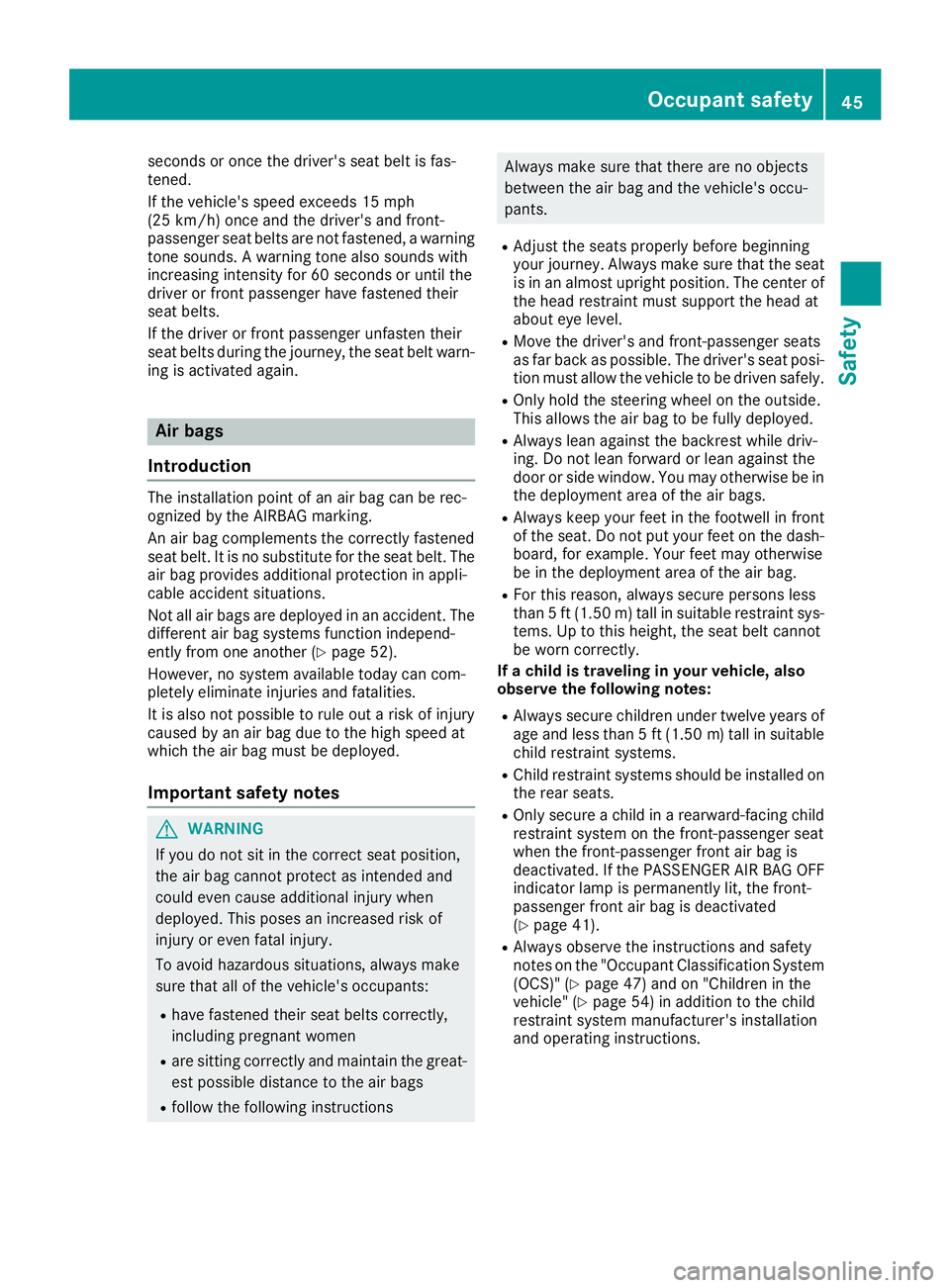
seconds or once the driver's seat belt is fas-tened.
If the vehicle's speed exceeds 15 mph(25 km/h) once and the driver's and front-passenger seat belts are not fastened, a warningtone sounds. A warning tone also sounds withincreasing intensity for 60 seconds or until thedriver or front passenger have fastened theirseat belts.
If the driver or front passenger unfasten theirseat belts during the journey, the seat belt warn-ing is activated again.
Air bags
Introduction
The installation point of an air bag can be rec-ognized by the AIRBAG marking.
An air bag complements the correctly fastenedseat belt. It is no substitute for the seat belt. Theair bag provides additional protection in appli-cable accident situations.
Not all air bags are deployed in an accident. Thedifferent air bag systems function independ-ently from one another (Ypage 52).
However, no system available today can com-pletely eliminate injuries and fatalities.
It is also not possible to rule out a risk of injurycaused by an air bag due to the high speed atwhich the air bag must be deployed.
Important safety notes
GWARNING
If you do not sit in the correct seat position,
the air bag cannot protect as intended and
could even cause additional injury when
deployed. This poses an increased risk of
injury or even fatal injury.
To avoid hazardous situations, always make
sure that all of the vehicle's occupants:
Rhave fastened their seat belts correctly,
including pregnant women
Rare sitting correctly and maintain the great-
est possible distance to the air bags
Rfollow the following instructions
Always make sure that there are no objects
between the air bag and the vehicle's occu-
pants.
RAdjust the seats properly before beginningyour journey. Always make sure that the seatis in an almost upright position. The center ofthe head restraint must support the head atabout eye level.
RMove the driver's and front-passenger seatsas far back as possible. The driver's seat posi-tion must allow the vehicle to be driven safely.
ROnly hold the steering wheel on the outside.This allows the air bag to be fully deployed.
RAlways lean against the backrest while driv-ing. Do not lean forward or lean against thedoor or side window. You may otherwise be inthe deployment area of the air bags.
RAlways keep your feet in the footwell in frontof the seat. Do not put your feet on the dash-board, for example. Your feet may otherwisebe in the deployment area of the air bag.
RFor this reason, always secure persons lessthan 5 ft (1.50 m) tall in suitable restraint sys-tems. Up to this height, the seat belt cannotbe worn correctly.
If a child is traveling in your vehicle, alsoobserve the following notes:
RAlways secure children under twelve years ofage and less than 5 ft (1.50m)tall in suitablechild restraint systems.
RChild restraint systems should be installed onthe rear seats.
ROnly secure a child in a rearward-facing childrestraint system on the front-passenger seatwhen the front-passenger front air bag isdeactivated. If the PASSENGER AIR BAG OFFindicator lamp is permanently lit, the front-passenger front air bag is deactivated(Ypage 41).
RAlways observe the instructions and safetynotes on the "Occupant Classification System(OCS)" (Ypage 47) and on "Children in thevehicle" (Ypage 54) in addition to the childrestraint system manufacturer's installationand operating instructions.
Occupant safety45
Safety
Z
Page 56 of 330
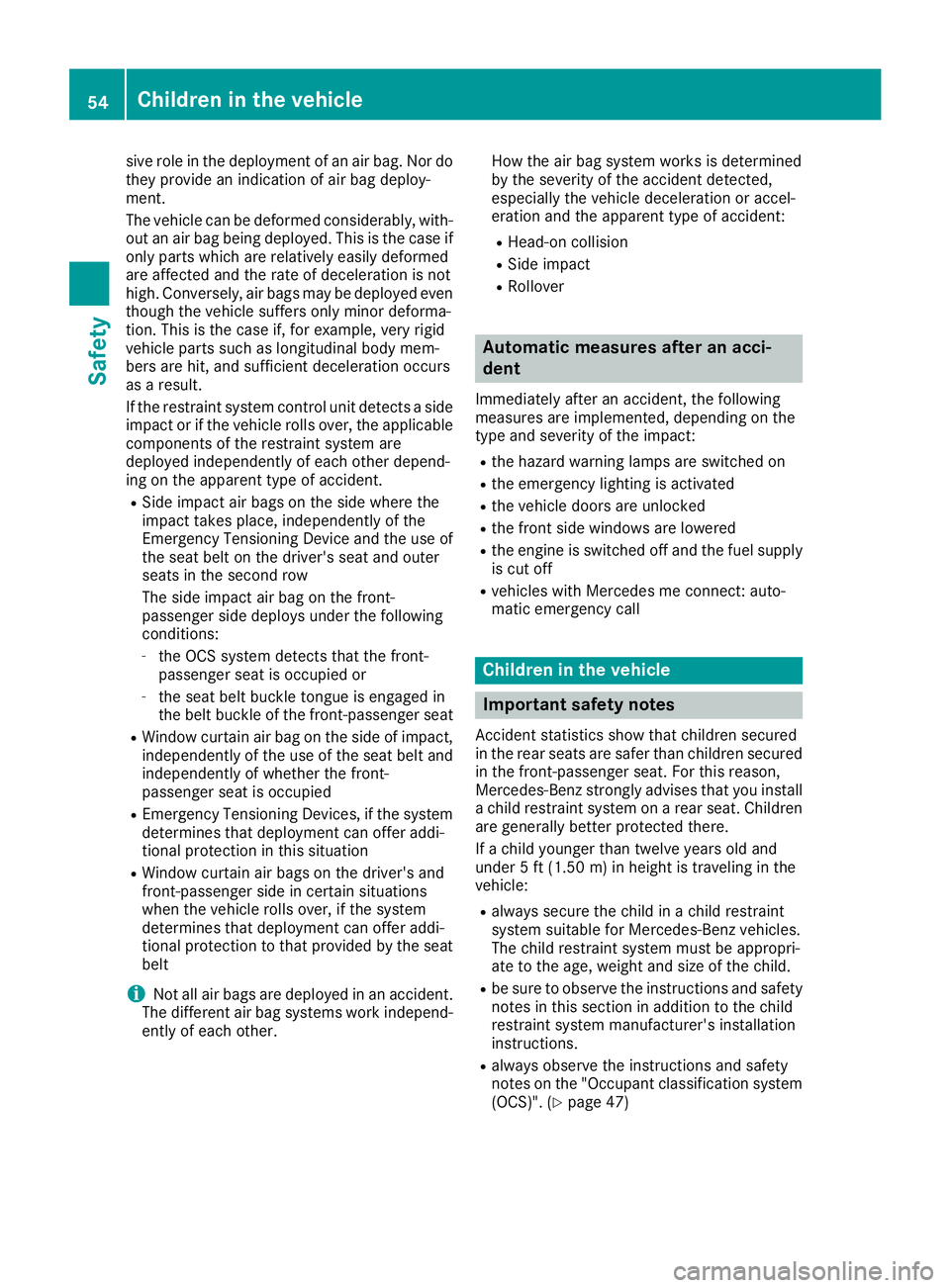
sive role in the deployment of an air bag. Nor dothey provide an indication of air bag deploy-ment.
The vehicle can be deformed considerably, with-out an air bag being deployed. This is the case ifonly parts which are relatively easily deformedare affected and the rate of deceleration is nothigh. Conversely, air bags may be deployed eventhough the vehicle suffers only minor deforma-tion. This is the case if, for example, very rigidvehicle parts such as longitudinal body mem-bers are hit, and sufficient deceleration occursas a result.
If the restraint system control unit detects a sideimpact or if the vehicle rolls over, the applicablecomponents of the restraint system aredeployed independently of each other depend-ing on the apparent type of accident.
RSide impact air bags on the side where theimpact takes place, independently of theEmergency Tensioning Device and the use ofthe seat belt on the driver's seat and outerseats in the second row
The side impact air bag on the front-passenger side deploys under the followingconditions:
-the OCS system detects that the front-passenger seat is occupied or
-the seat belt buckle tongue is engaged inthe belt buckle of the front-passenger seat
RWindow curtain air bag on the side of impact,independently of the use of the seat belt andindependently of whether the front-passenger seat is occupied
REmergency Tensioning Devices, if the systemdetermines that deployment can offer addi-tional protection in this situation
RWindow curtain air bags on the driver's andfront-passenger side in certain situationswhen the vehicle rolls over, if the systemdetermines that deployment can offer addi-tional protection to that provided by the seatbelt
iNot all air bags are deployed in an accident.The different air bag systems work independ-ently of each other.
How the air bag system works is determinedby the severity of the accident detected,especially the vehicle deceleration or accel-eration and the apparent type of accident:
RHead-on collision
RSide impact
RRollover
Automatic measures after an acci-
dent
Immediately after an accident, the followingmeasures are implemented, depending on thetype and severity of the impact:
Rthe hazard warning lamps are switched on
Rthe emergency lighting is activated
Rthe vehicle doors are unlocked
Rthe front side windows are lowered
Rthe engine is switched off and the fuel supplyis cut off
Rvehicles with Mercedes me connect: auto-matic emergency call
Children in the vehicle
Important safety notes
Accident statistics show that children securedin the rear seats are safer than children securedin the front-passenger seat. For this reason,Mercedes-Benz strongly advises that you installa child restraint system on a rear seat. Childrenare generally better protected there.
If a child younger than twelve years old andunder 5 ft (1.50 m) in height is traveling in thevehicle:
Ralways secure the child in a child restraintsystem suitable for Mercedes-Benz vehicles.The child restraint system must be appropri-ate to the age, weight and size of the child.
Rbe sure to observe the instructions and safetynotes in this section in addition to the childrestraint system manufacturer's installationinstructions.
Ralways observe the instructions and safetynotes on the "Occupant classification system(OCS)". (Ypage 47)
54Children in the vehicle
Safety
Page 57 of 330
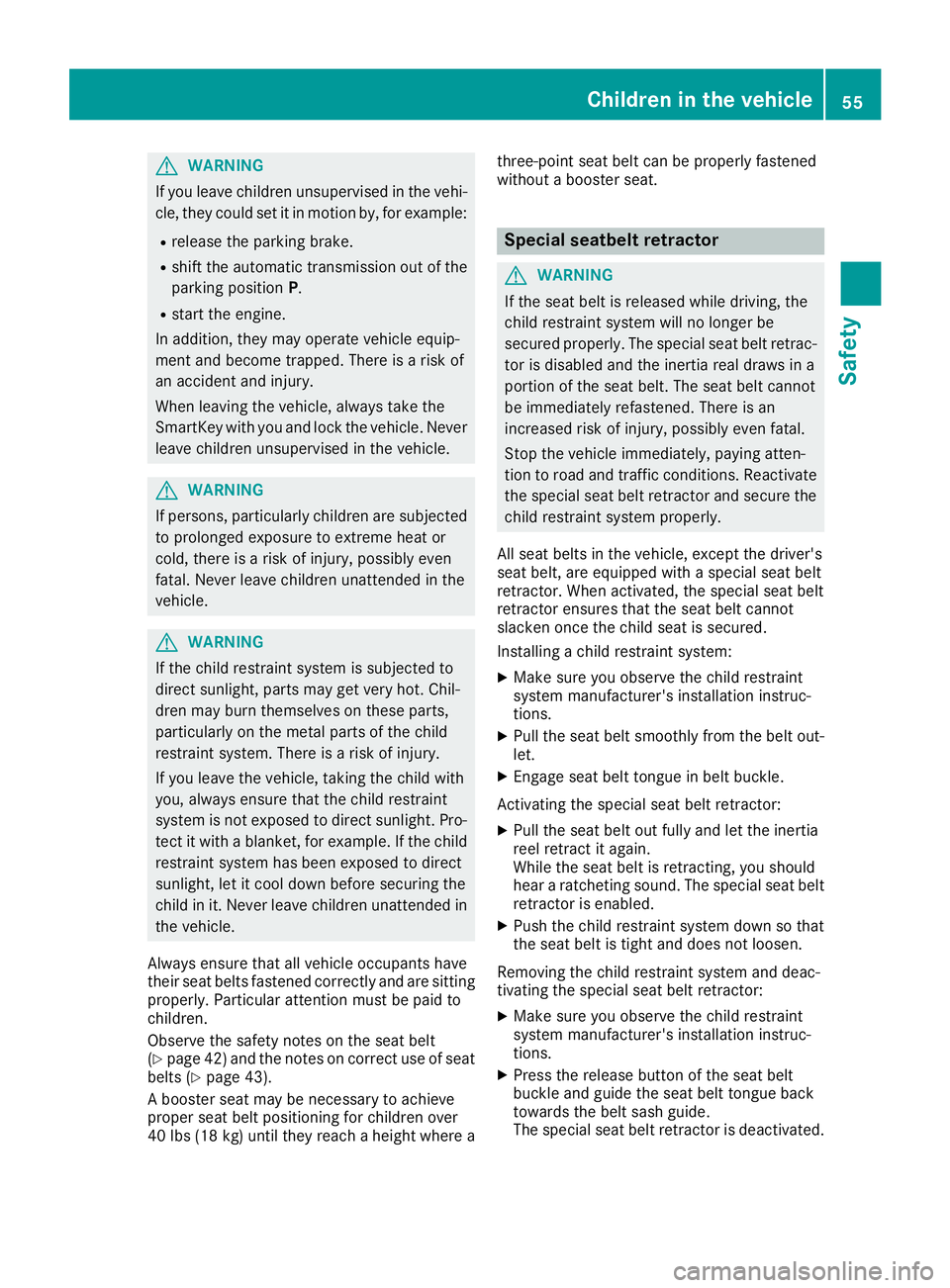
GWARNING
If you leave children unsupervised in the vehi-
cle, they could set it in motion by, for example:
Rrelease the parking brake.
Rshift the automatic transmission out of the
parking positionP.
Rstart the engine.
In addition, they may operate vehicle equip-
ment and become trapped. There is a risk of
an accident and injury.
When leaving the vehicle, always take the
SmartKey with you and lock the vehicle. Never
leave children unsupervised in the vehicle.
GWARNING
If persons, particularly children are subjected
to prolonged exposure to extreme heat or
cold, there is a risk of injury, possibly even
fatal. Never leave children unattended in the
vehicle.
GWARNING
If the child restraint system is subjected to
direct sunlight, parts may get very hot. Chil-
dren may burn themselves on these parts,
particularly on the metal parts of the child
restraint system. There is a risk of injury.
If you leave the vehicle, taking the child with
you, always ensure that the child restraint
system is not exposed to direct sunlight. Pro-
tect it with a blanket, for example. If the child
restraint system has been exposed to direct
sunlight, let it cool down before securing the
child in it. Never leave children unattended in
the vehicle.
Always ensure that all vehicle occupants havetheir seat belts fastened correctly and are sittingproperly. Particular attention must be paid tochildren.
Observe the safety notes on the seat belt(Ypage 42) and the notes on correct use of seatbelts (Ypage 43).
A booster seat may be necessary to achieveproper seat belt positioning for children over40 lbs (18 kg) until they reach a height where a
three-point seat belt can be properly fastenedwithout a booster seat.
Special seatbelt retractor
GWARNING
If the seat belt is released while driving, the
child restraint system will no longer be
secured properly. The special seat belt retrac-
tor is disabled and the inertia real draws in a
portion of the seat belt. The seat belt cannot
be immediately refastened. There is an
increased risk of injury, possibly even fatal.
Stop the vehicle immediately, paying atten-
tion to road and traffic conditions. Reactivate
the special seat belt retractor and secure the
child restraint system properly.
All seat belts in the vehicle, except the driver'sseat belt, are equipped with a special seat beltretractor. When activated, the special seat beltretractor ensures that the seat belt cannotslacken once the child seat is secured.
Installing a child restraint system:
XMake sure you observe the child restraintsystem manufacturer's installation instruc-tions.
XPull the seat belt smoothly from the belt out-let.
XEngage seat belt tongue in belt buckle.
Activating the special seat belt retractor:
XPull the seat belt out fully and let the inertiareel retract it again.While the seat belt is retracting, you shouldhear a ratcheting sound. The special seat beltretractor is enabled.
XPush the child restraint system down so thatthe seat belt is tight and does not loosen.
Removing the child restraint system and deac-tivating the special seat belt retractor:
XMake sure you observe the child restraintsystem manufacturer's installation instruc-tions.
XPress the release button of the seat beltbuckle and guide the seat belt tongue backtowards the belt sash guide.The special seat belt retractor is deactivated.
Children in the vehicle55
Safety
Z
Page 94 of 330

GWARNING
If the driver's seat is not engaged, it could
move forwards as far as the next catch during
movement such as braking or abrupt changes
of direction. As a result, you would be pushed
against your seat belt by the unsecured driv-
er's seat.
This could cause you to lose control of the
vehicle. The seat belt cannot protect as inten-
ded and could result in additional injury.
There is a risk of an accident and injury.
Before every journey, make sure that the driv-
er's seat is fully engaged.
Observe the safety notes on "Air bags"(Ypage 45) and "Children in the vehicle"(Ypage 54).
GWARNING
If the driver's seat is not engaged, it could
move unexpectedly while the vehicle is in
motion. This could cause you to lose control of
the vehicle. There is a risk of an accident.
Always make sure that the driver's seat is
engaged before starting the vehicle.
GWARNING
You could lose control of your vehicle if you do
the following while driving:
Radjust the driver's seat, head restraint,
steering wheel or mirrors
Rfasten the seat belt
There is a risk of an accident.
Adjust the driver's seat, head restraint, steer-
ing wheel and mirror and fasten your seat belt
before starting the engine.
GWARNING
If you adjust the seat height carelessly, you or
other vehicle occupants could be trapped and
thereby injured. Children in particular could
accidentally press the electrical seat adjust-
ment buttons and become trapped. There is a
risk of injury.
While moving the seats, make sure that your
hands or other body parts do not get under the
lever assembly of the seat adjustment sys-
tem.
!To prevent damage to the seats and the seatheating, observe the following notes:
RDo not spill liquids onto the seats. Dry theseats as soon as possible if liquid does getspilled on the seats.
RIf the seat covers are damp or wet, do notswitch on the seat heating. Also, do not usethe seat heating to dry the seats.
RClean the seat covers as recommended;see the "Interior care" section.
RDo not transport heavy loads on the seats.Do not place pointed objects on the seatcushions such as knives, nails or tools.Where possible, use the seats only for car-rying passengers.
RWhen operating the seat heating, do notcover the seats with insulating materials,e.g. blankets, coats, bags, protective cov-ers, child seats or booster seats.
RWhen the seat heating is switched on, theseat surface can be damaged as a result ofobjects being placed on the seats, forexample, seat cushions, child seats andprotective covers not approved byMercedes-Benz.
!Make sure that there are no objects in thefootwell under or behind the seats when mov-ing the seats back. There is a risk that theseats and/or the objects could be damaged.
iFurther related subjects:
RCargo compartment enlargement (foldingdown the rear seats) (Ypage 242)
92Seats
Seats, steering wheel and mirrors
Page 96 of 330

Adjusting the head restraints
Important safety notes
GWARNING
You could lose control of your vehicle if you do
the following while driving:
Radjust the driver's seat, head restraint,
steering wheel or mirrors
Rfasten the seat belt
There is a risk of an accident.
Adjust the driver's seat, head restraint, steer-
ing wheel and mirror and fasten your seat belt
before starting the engine.
GWARNING
If the head restraints are not installed or not
adjusted correctly, they cannot provide pro-
tection as intended. There is an increased risk
of injury in the head and neck area, e.g. in the
event of an accident or when braking.
Always drive with the head restraints instal-
led. Before driving off, make sure for every
vehicle occupant that the center of the head
restraint supports the back of the head at
about eye level.
Using the fore-and-aft adjustment, adjust thehead restraint so that it is as close as possible toyour head.
General notes
For vehicles with sports seats you cannot adjustthe front head restraints or the outer rear headrestraints.
Adjusting the head restraints manually
Adjusting the head restraint height
XTo raise:pull the head restraint up to thedesired position.
XTo lower:press release catch�Cin the direc-tion of the arrow and push the head restraintdown to the desired position.
Adjusting the fore/aft position of the
head restraint
With this function you can adjust the distancebetween the head restraint and the back of theseat occupant's head.
XTo move forwards:pull the head restraintforwards in the direction of the arrow until itengages.There are several notches.
XTo move backwards:press and hold releasebutton�Cand push the head restraint back-wards.
XWhen the head restraint is in the desired posi-tion, release the button and make sure thatthe head restraint is engaged in position.
94Seats
Seats , ste ering wheel and mirrors
Page 97 of 330
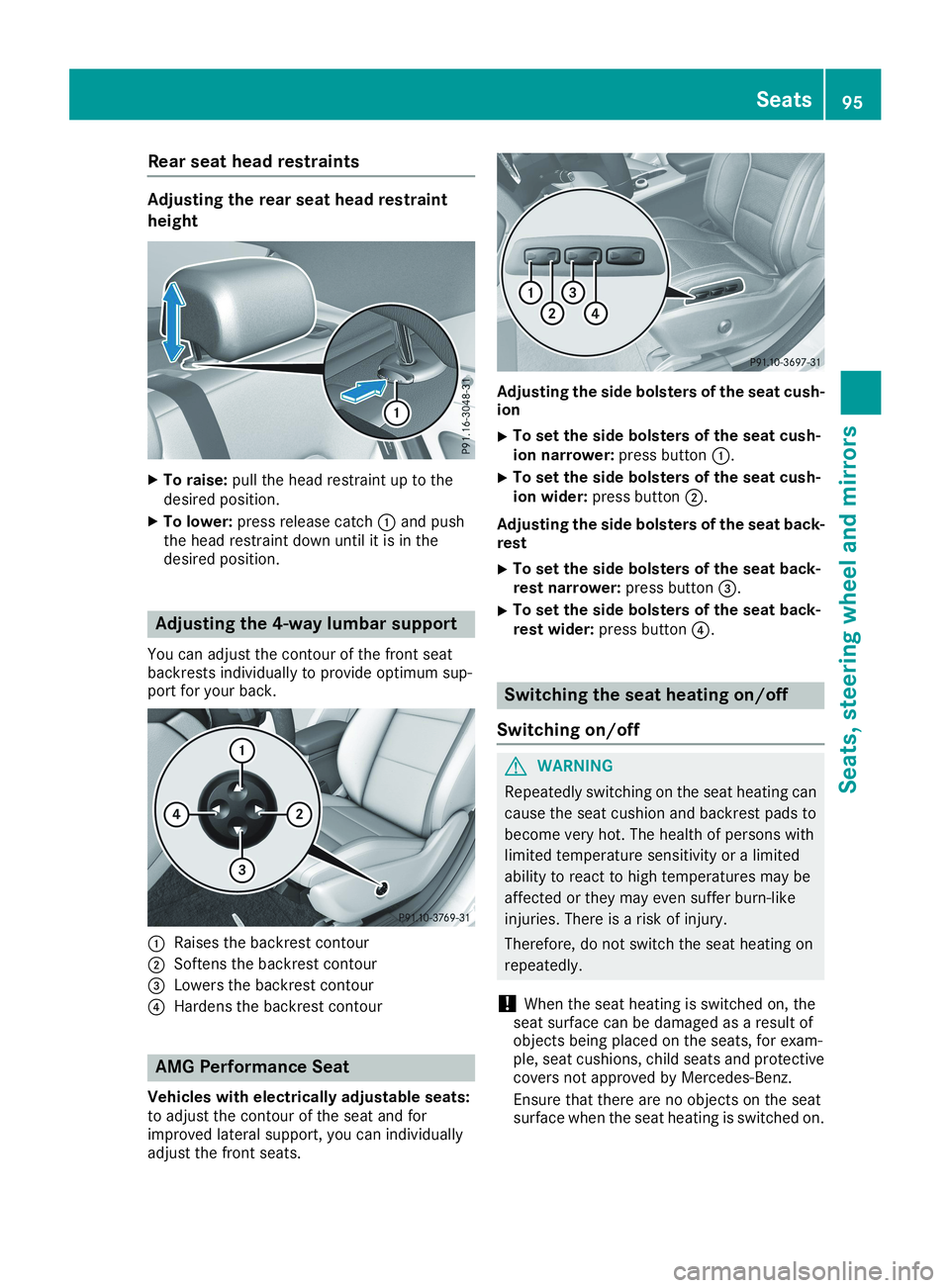
Rear seat head restraints
Adjusting the rear seat head restraint
height
XTo raise:pull the head restraint up to thedesired position.
XTo lower:press release catch�Cand pushthe head restraint down until it is in thedesired position.
Adjusting the 4-way lumbar support
You can adjust the contour of the front seatbackrests individually to provide optimum sup-port for your back.
�CRaises the backrest contour
�DSoftens the backrest contour
�